The United States Women’s National Team (USWNT) has been a dominant force in women’s international football for the past decade with back-to-back World Cup wins in 2015 and 2019. Their golden generation has delivered on their promise and are playing to their maximum potential. The spine of the team has remained relatively the same across both World Cups who have been the backbone of their success. Alyssa Naeher, Abby Dahlkemper, Julie Ertz, and Alex Morgan have largely been mainstays in the team with Ertz arguably the most crucial of the lot. Having played across central defensive midfield and centre-back, Ertz has seamlessly slotted into both roles and continued producing high-level performances.
So, where does the USWNT need her most? The aim of this tactical analysis is to compile a report on Ertz to identify her strengths and understand which position is stronger for the USWNT. I will use a mixture of footage and data to identify her qualities and compare her to other options available to head coach Vlatko Andonovski. To begin the scout report, I will start with a short profile followed by Andonovski’s system he has implemented since his arrival in October 2019.
Profile
Julie Ertz is a 28-year-old central defensive midfielder / centre-back playing for the United States Women’s National Team and Chicago Red Stars. Ertz is a versatile player capable of playing multiple positions seamlessly utilising her skill set to maximum effect. Her role is that of a creative, possession recycler in possession and defensive cover out of possession. The common denominator between the two phases is Ertz’s intelligence in making the right decision in situations. Knowing when to make a run, tackle, or pass is a hallmark of Ertz’s play and is what makes her such an integral player in the team regardless of her position. Going back to 2017, Ertz was shifted from centre-back to a defensive centre midfield position as former coach Jill Ellis experimented with new formations.
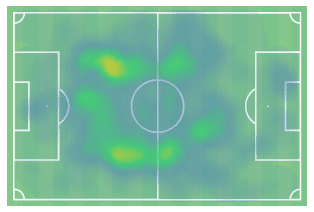
The heat maps below show her average movement for the USWNT between the 2019 Women’s World Cup and 2020 She Believes Cup. This shows her most active areas illustrating her presence in both halves being able to influence these areas through the attributes mentioned.
Vlatko Andonovski’s USWNT & Julie Ertz’s role
The departure of Ellis has seen the USWNT change their style ever so slightly. During the 2019 World Cup, Ellis’ team were more of a high-pressing, counter-attacking setup with an emphasis on the front three. The midfield three were tasked with defensive organisation and controlling play. Depending on the personnel deployed in midfield, one midfielder would make forward runs in support of the front three. The two wide players would largely linger in attack. Andonvoski has changed this slightly. He has retained the 4-3-3 formation but experimented with his starting XI’s throughout the tournament.
However, in each game, we could see the philosophy Andonovski was trying to implement. The defence was tasked with building out from the back, with the defensive midfielder, most often Ertz, always dropping in as a point of reference and distraction. While the centre-backs would pass horizontally, the presence of the defensive midfielder is to act as a focal point for the opposition to focus on. When possession did reach Ertz, whether from the full-backs or centre-backs, Ertz would then look for one of the interior midfielders or wide players.
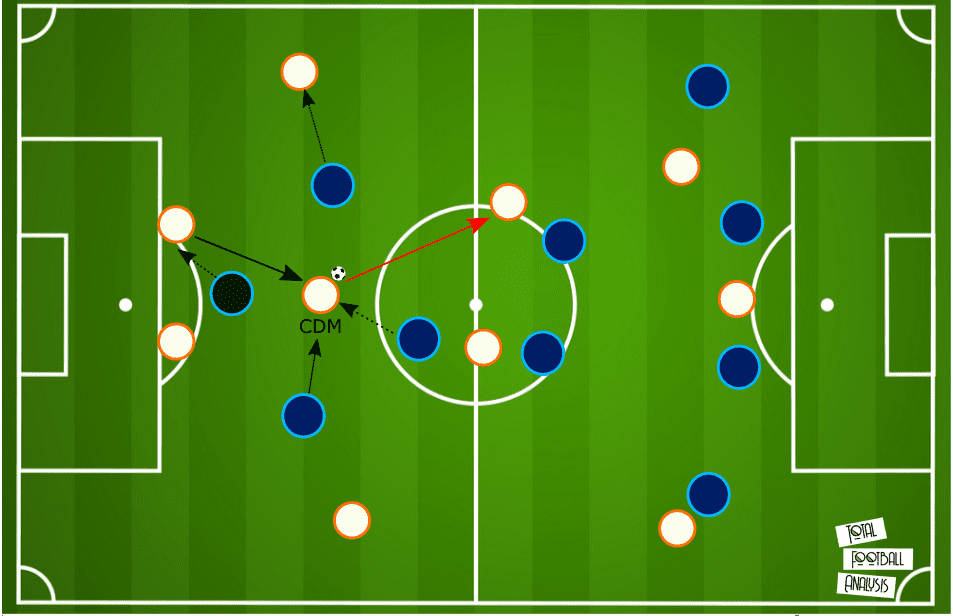
Midfield and attack seemed to have more cohesion with at least one central midfielder pushing forward in support of the forward players at all times. Sometimes two will join on the far side, especially when the team has the majority of possession. The left-winger would drop into a more central area allowing the left-back and central midfielder to push forward to create overloads in the channels. The central striker would make vertical movements to link-up play and be an extra player in midfield. Meanwhile, Ertz will hold a high line behind the attacking players to create a base and thread passes through to the forward players especially when the USWNT dominate possession. If the opportunity presents itself, Ertz will join in the attack but more often than not will sit slightly deeper than her two teammates to protect the defence.
In possession
The first part of the analysis will be broken up into two sections detailing Ertz’s attributes in possession, and out of possession. It is imperative that we understand the different attributes Ertz possesses to pinpoint her best position. The defensive midfielder must be comfortable with the ball and not only be able to receive possession but distribute it well. For this reason, I will look to analyse Ertz’s composure, ball progression, and tactical intelligence in different situations.
Starting off with her qualities in possession, Ertz’s most obvious attribute is her ability to carry and move the ball. Having experience as a ball-playing centre-back, being able to comfortably pass, and dribble in possession is something Ertz is very capable of. The system that the USWNT employ means that they need a calm presence and stable ball carrier in midfield who is able to recycle possession further forward.
Ertz’s dribbling can be considered effective as she’s able to combine her on the ball skill with her passing range. Ertz’s dribbling can be seen as unorthodox with the odd heavy touch but is effective; however, it can cause losses. What she really does excel is in her first touch to then find a passing option. Her passing range from this position alone is also good by being able to play short and simple passes as well as expansive long-ranged ones.
Ertz’s aerial passes may be wayward but other key passes like final third passes are often her pass of choice. This is illustrated in her 16.9 forward passes with a impressive 60.7% accuracy rate and 9.12 passes to the final third with a 55% accuracy rate. If the opportunity presents itself, Ertz will push forward in possession and make her forward passes higher up the pitch.
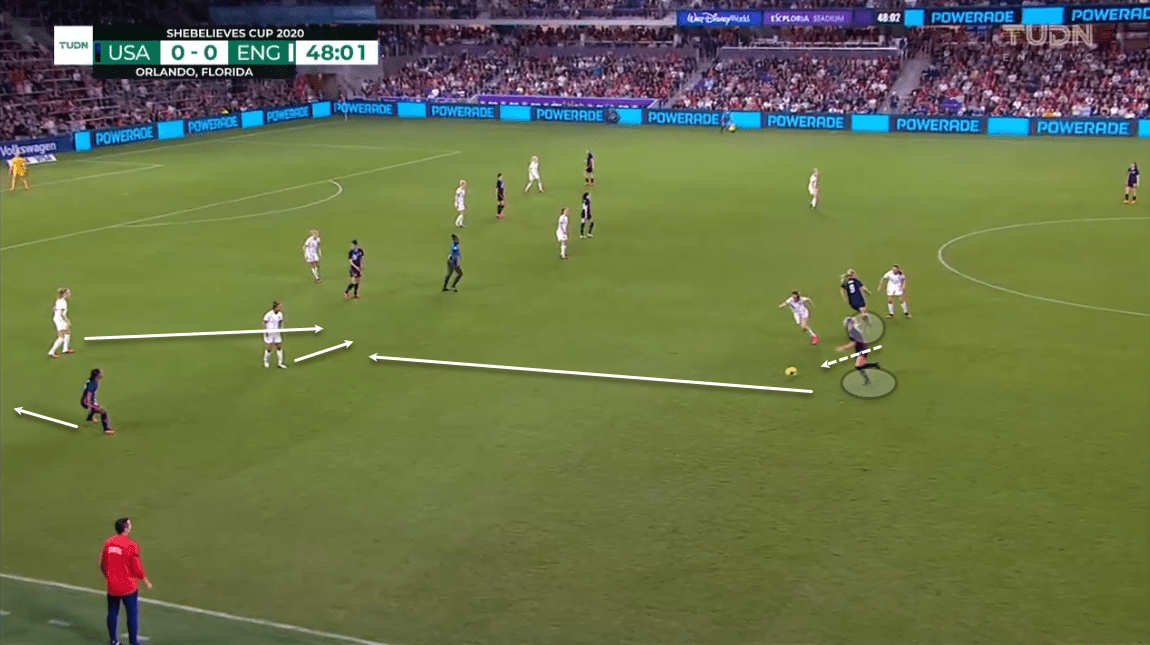
As this example shows, the team have pushed up against England with Lindsay Horan looking for a way forward. Ertz manages to wrap around the back and attempts to drive into the vacant space between England’s midfield and defence.
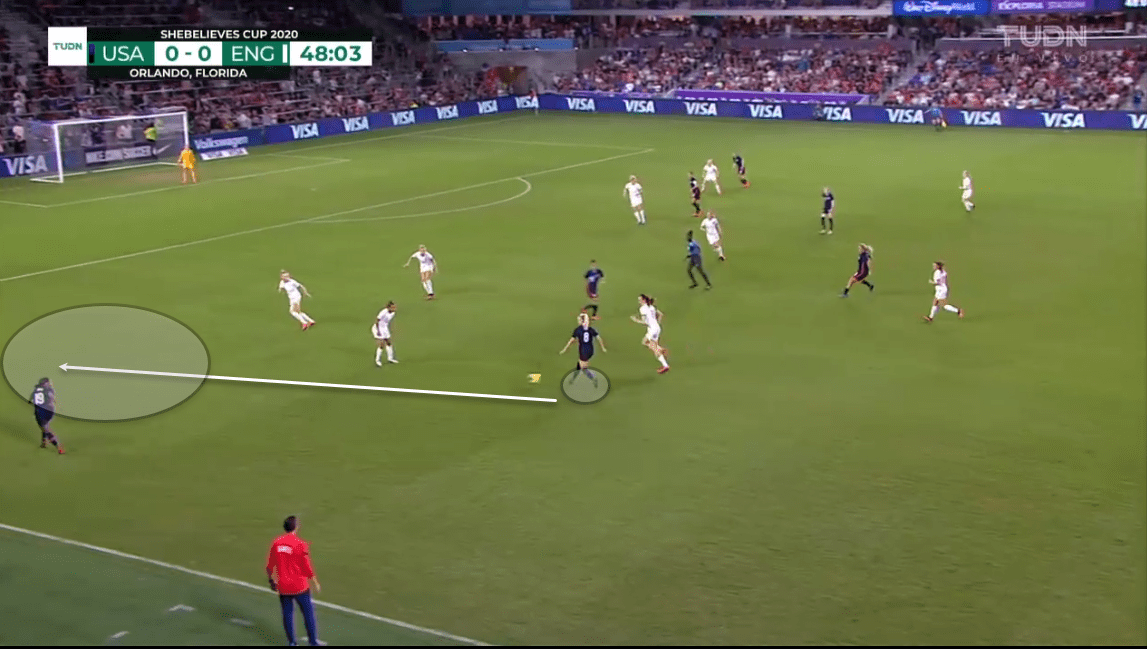
Ertz dribbles forward, baiting the Lionesses’ defenders to press her, pulling them into a more narrow position. This allows Crystal Dunn, the ex-Chelsea defender, to stay wide and receive Ertz’s pass which can be used to deliver an early cross. Ertz isn’t an anchorman but rather a defensive midfielder who possesses traits similar to that of a ‘Segundo Volante’. A player that holds a box-to-box role from a deeper position.
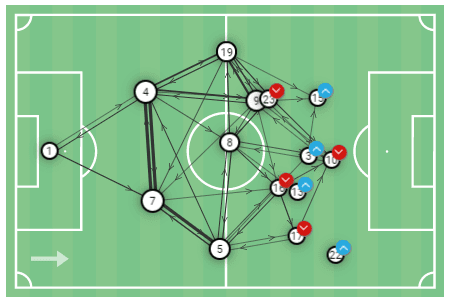
This pass map is from the USWNT recent game against England with the team using two different formations. Starting off with a 4-1-3-2 and later a 4-2-3-1. In both formations, Ertz played as the deepest midfielder as the pass map highlights. While the passing connections between Ertz and the defenders may not be frequent, there are links with the majority of the attacking players. This illustrates Ertz’s role as someone the players trust to relieve pressure if the opposition proves hard to break down or are pressing deep in their defensive half.
Another one of Ertz’s core features here is her ability to relieve pressure in a highly contested area of the pitch. Teams that employ a high press will usually mark the number ‘6’ tightly in order to try and recover the ball higher and stop the focal point from building out from the back. Being able to withstand and bypass opposition pressure can pull players out of position opening up spaces in behind. If the attacking midfielder commits to marking Ertz, they inevitably give up the space between the central midfielders and themselves.
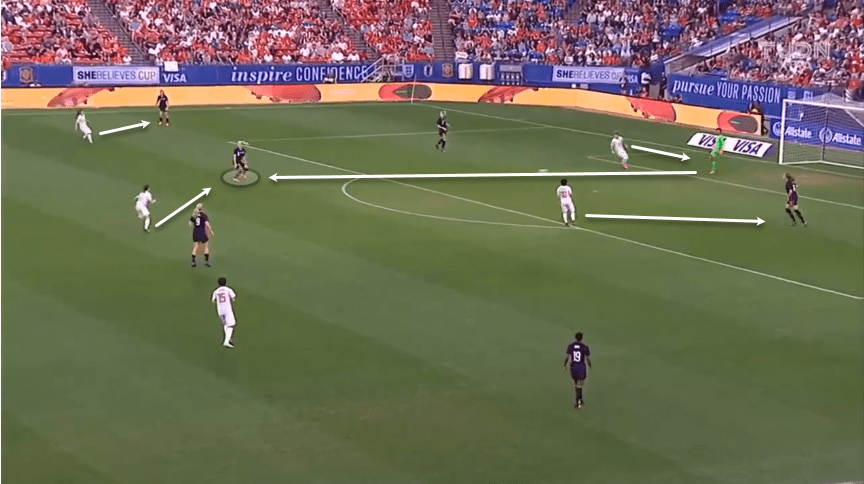
Here Japan have clearly employed a high pressing strategy where they force Adrianna Franch to act quickly. Ertz offers herself as a passing option and quickly looks over her shoulder to decide on the next move as she receives possession. A Japanese attacker can be seen pressing Ertz too.
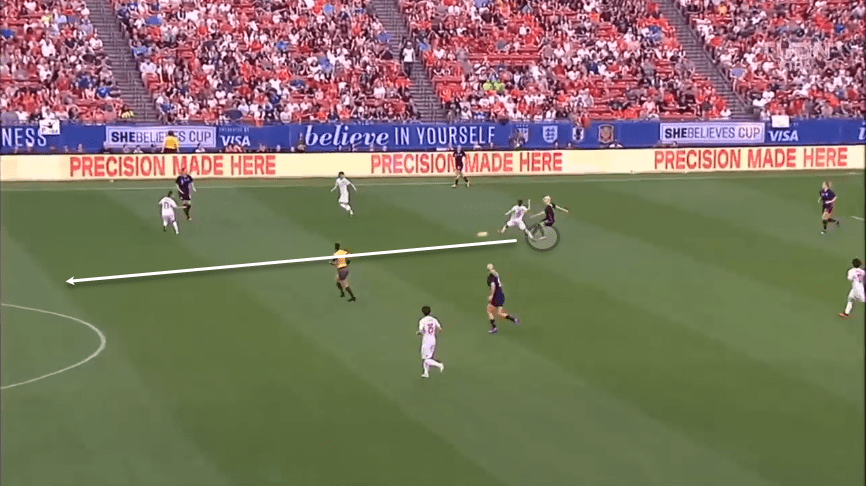
Ertz manages to receive the pass, dribble forward and release a quick pass into the forward line. The highlighted area is the space vacated by the Japanese players because of their high press. A player like Ertz can take advantage of this because of her possession abilities and drive her team forward.
Out of possession
Playing in Ertz’s position means she must be extremely competent off the ball as much as she is on it. The importance of being able to anticipate and identify opposition movement is vital to playing the role and position well.
Ertz’s defensive positioning varies depending on the type of opposition they face. Against teams that will sit back, she will push up but look to hold as the deepest lying player to defend against counter-attacks. Against teams that attempt to play their way through, Ertz will sit deeper and play closer to the centre-backs. Ertz will drop in between the two central defenders and become a faux third centre-back. The territorial coverage map below illustrates the areas of the pitch Ertz is able to intercept balls. Most of her points of impact are in the 18-yard box. Even though this is for all her games this season, it highlights Ertz’s movement and positioning in defensive areas.
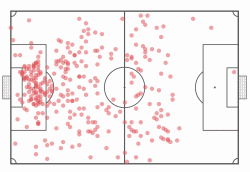
The USWNT are possession-hungry which means Ertz will naturally be positioned higher. From here, Ertz will patrol the midfield area aggressively and step in to intercept passes to stop attacks. Ertz will play as a counter-balance to Horan (formerly of Paris Saint-Germain) who plays a more attacking role. The American’s physical presence and hard-working nature can battle against most midfield opposition. This enables her to step in and turnover possession for the USWNT. When she plays this aggressive role, there is some leeway to her positioning because of the support she has around her and high tempo game when the team pushes forward.
Ertz registered 10.48 recoveries/90 across nine matches since the World Cup. 50.5% of them came in the opposition half, showing her preference to take on players in the middle and final third. This is a high proportion of recoveries for a defensive midfielder and in line with the team’s tactics. She showed this against Spain the She Believes Cup which can be seen in the example below.
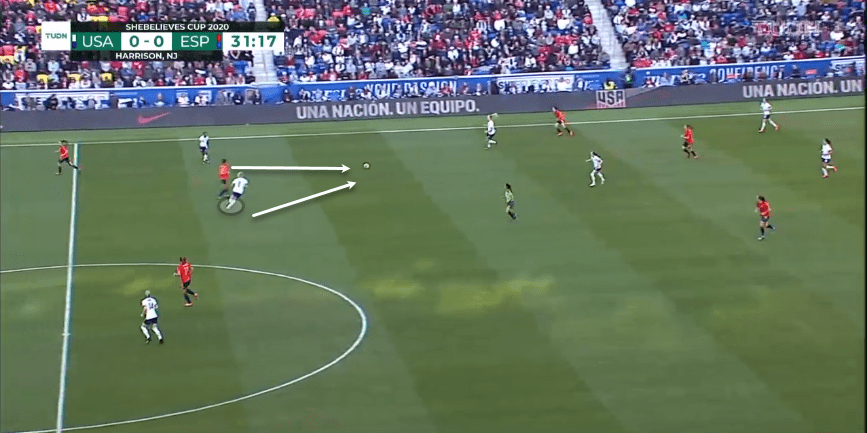
The Spaniards are trying to progress play and have passed the ball into midfield to try and get their midfielders to combine and get in between the lines. Ertz’s higher positioning and anticipation has seen her sense danger and pushes forward to intercept the incoming pass.
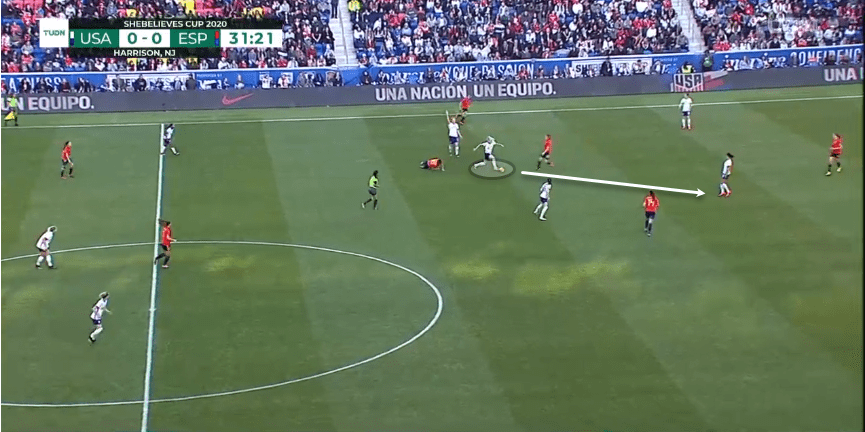
Ertz manages to outmuscle the Spanish midfielder and come away with a turnover. Though she takes a heavy touch, Ertz manages to pass a ball into the striker continuing her run into the final third. These are the type of situations which Ertz thrives in and is able to do her best work. This highlights her anticipation and aggressiveness off the ball and how effective it can be for the system Andolovski wants to implement.
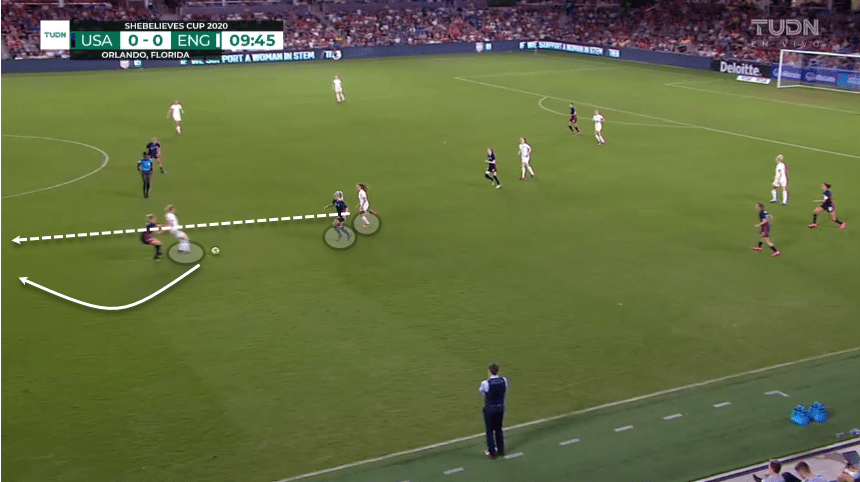
However, I feel this aggressiveness is a potential downfall for Ertz and the position she plays in. Her role is to protect the back four and while she can venture further forward, Ertz must be wary of her positioning. Generally looking at Ertz’s last 86 events, she’s lost 60.5% of her 1 vs 1 duels with a mere 36% win percentage. The image above is indicative of this with Ertz in an advanced position against England with Georgia Stanway sending the ball past her into Manchester City striker Ellen White. If the centre-forward is able to turn her marker, Ertz will be too far away.
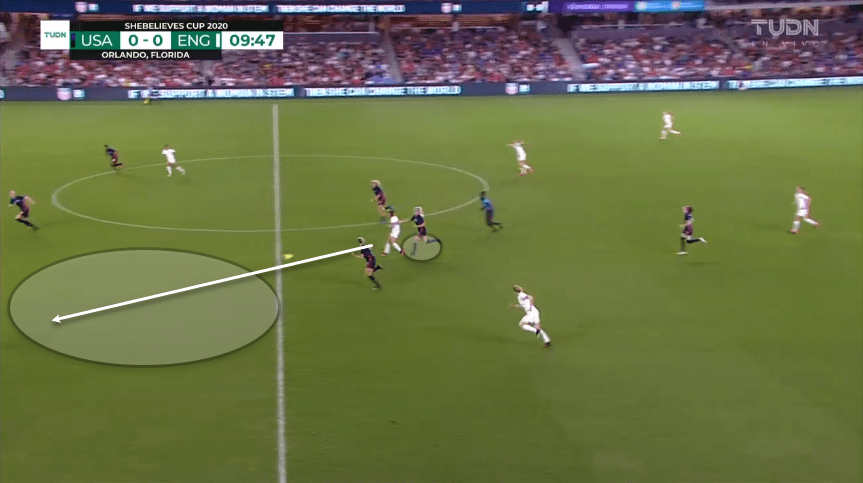
White manages to hold on to the ball and plays in Stanway. The vacant space in behind is exposed with no real cover. This allows the Lionesses to counter-attack leaving them in a 2 vs 2 scenario.
So where should the USWNT play Ertz?
So, this now begs the question, where does the USWNT need Ertz? At centre-back or defensive midfield? To answer this question, I will look to analyse and compare Ertz to two of her teammates from the two positions along with the aforementioned analysis to come up with a decisive answer. At the moment, the USWNT have a number of defensive and midfield options but the question is as much about replacing Ertz in midfield and maintaining the quality. I will start off by comparing Ertz with Sam Mewis to see if she has the capacity to replace Ertz in midfield if she were to move further back.
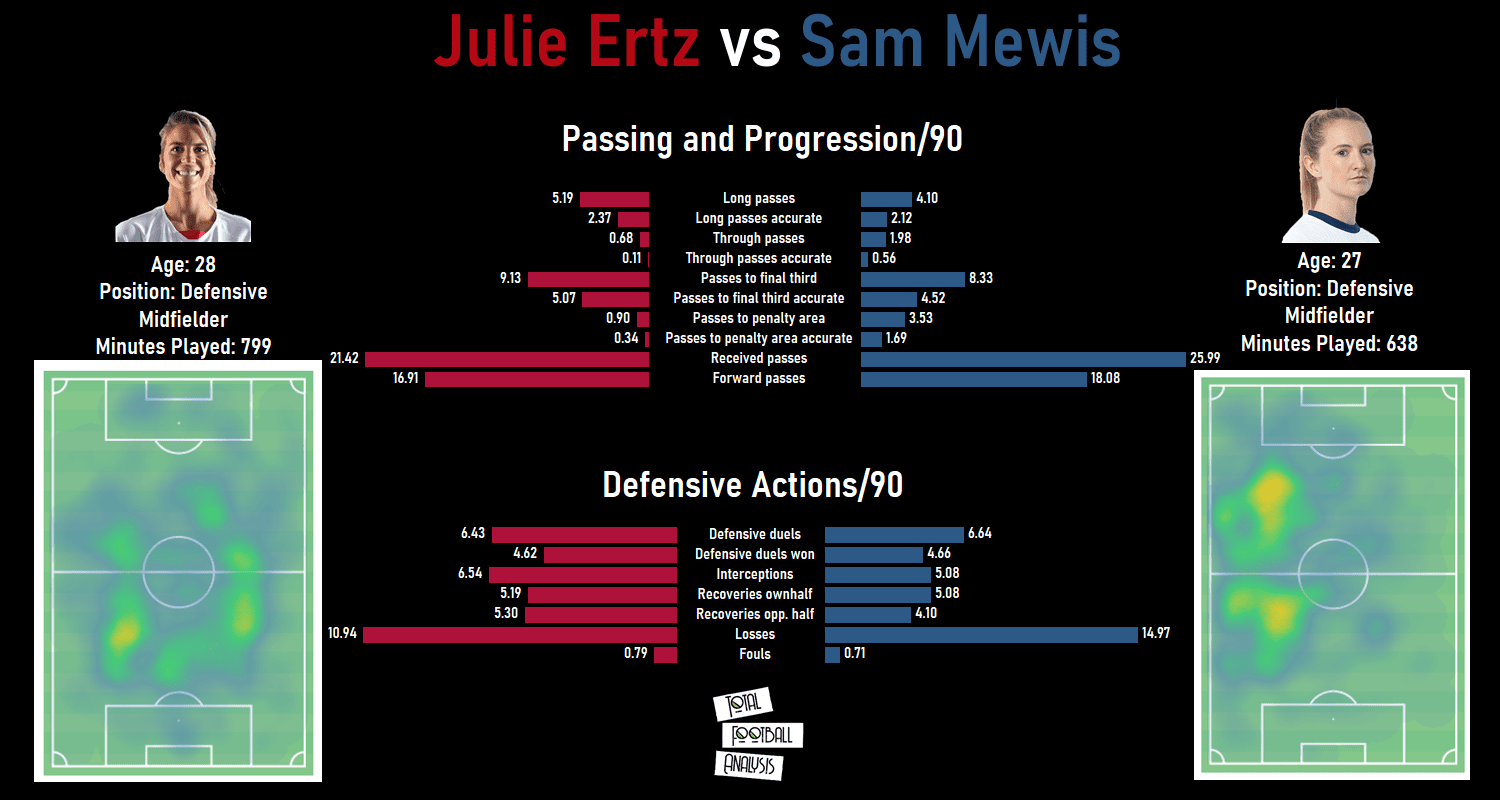
This player comparison gives us a holistic view of Ertz’s statistics against Mewis. It is worth mentioning that Mewis is not a natural defensive midfielder, however, her skill set would be well suited to the role Andolovski wants in this position. Starting with the heatmaps, Mewis is very one-sided due to her position, however, there is heavy activity coming from in the left defensive midfield channel showing her defensive awareness. Both Ertz and Mewis have very similar passing statistics with one slightly better than the other. I believe the most important ones to focus on are the number of passes to the final third and received passes. The final third passes indicate Mewis’ playmaking ability and while the statistics are higher, it shows that Mewis can aptly play positive passes from deep.
Defensively, Ertz has better statistics but not by much. With the exception of defensive duels/90, Ertz shows that she is more aggressive when it comes defending. Mewis is more focused on her link-up play. The advantage of Mewis playing the Ertz role is that her statistics are comparable and if moved to a deeper role, she can continue to play her natural passing game and start contributing more defensively. Mewis’ positioning and spatial awareness are excellent so slotting into the ‘6’ role is possible.
Next, I will compare Dahlkemper and Ertz to see if Ertz’s statistics are comparable to the central defenders. From the outset, we can see Ertz is much more prevalent defensively, while Dahlkemper has an edge in the passing metrics.
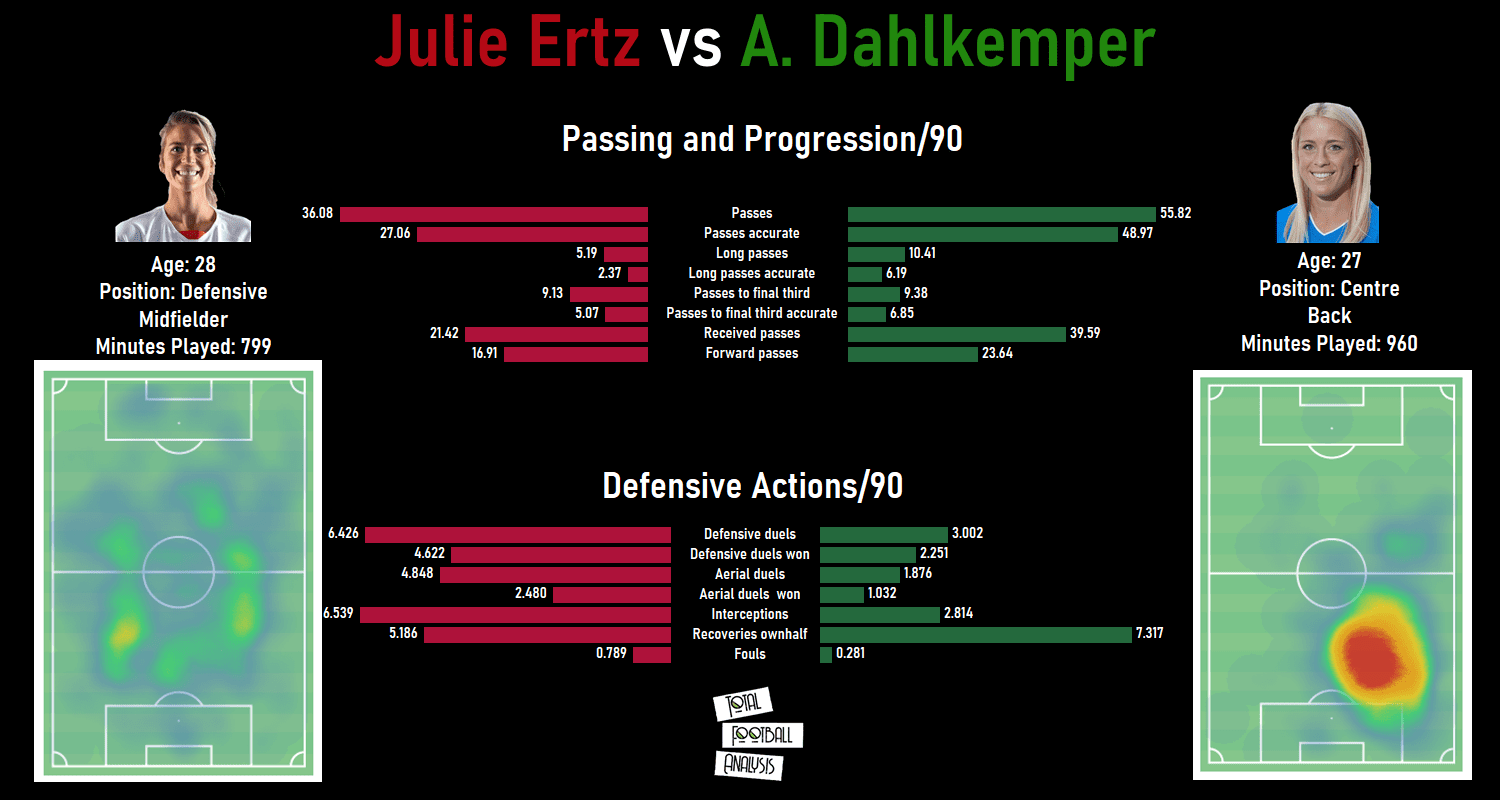
Part of the reason behind this is USWNT’s possession and ability to win the ball in the middle third of the pitch. Playing with three midfielders enables them to press and counter-attack before the opposition has a chance to reach the defensive third. What is most surprising is Dahlkemper’s passes to the final third being slightly higher than Ertz’s. Opposition teams will look to press the USWNT higher up the pitch which at times will trigger Dahlkemper to pass directly into the final third. I also found the recoveries statistic surprising given Ertz plays further forward. Dahlkemper seems to make more recoveries which could suggest Ertz’s defensive positioning needs work.
From the heatmap, we can see Ertz is one to move horizontally and vertically across the pitch covering ground and often playing as a third centre-back. From this position, Dahlkemper’s movement might be less but her positioning and intelligence is the most important aspect. If Ertz were to play here, she would need to limit her forays forward and be more disciplined when it comes to defending because she is the last line of defence.
Final Remarks
Though she does play at centre-back for Chicago Red Stars, the USWNT play a different system and I believe putting all the facts and analysis together, Ertz would be much more suited to her role in midfield. There are a number of quality options at centre-back with Dahlkemper and Becky Sauerbrunn two of the best pairings in world football. Tierna Davidson, Sarah Gorden, and Alana Cook all available to play in the position. While there is no shortage of quality in midfield, currently there is no player in the squad capable of filling in the Ertz role. Mewis might be the closest competitor but others such as Horan, Morgan Brian, Danielle Colaprico, and Rose Lavelle are better served further forward.
Ertz is such a versatile player for the USWNT and time is on their side with Ertz entering her prime now at the age of 28. With another couple of major tournaments under Ertz’s belt left, she could very well move back into defence and replace Sauerbrunn who is 35.



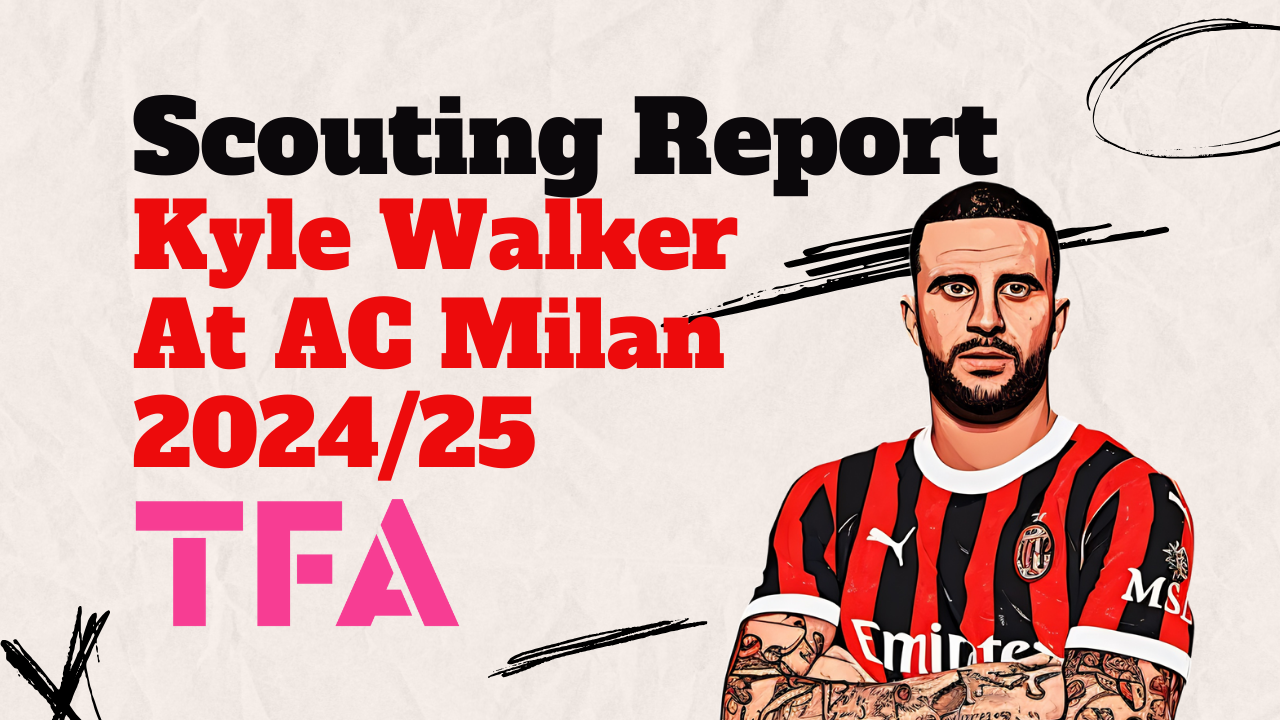
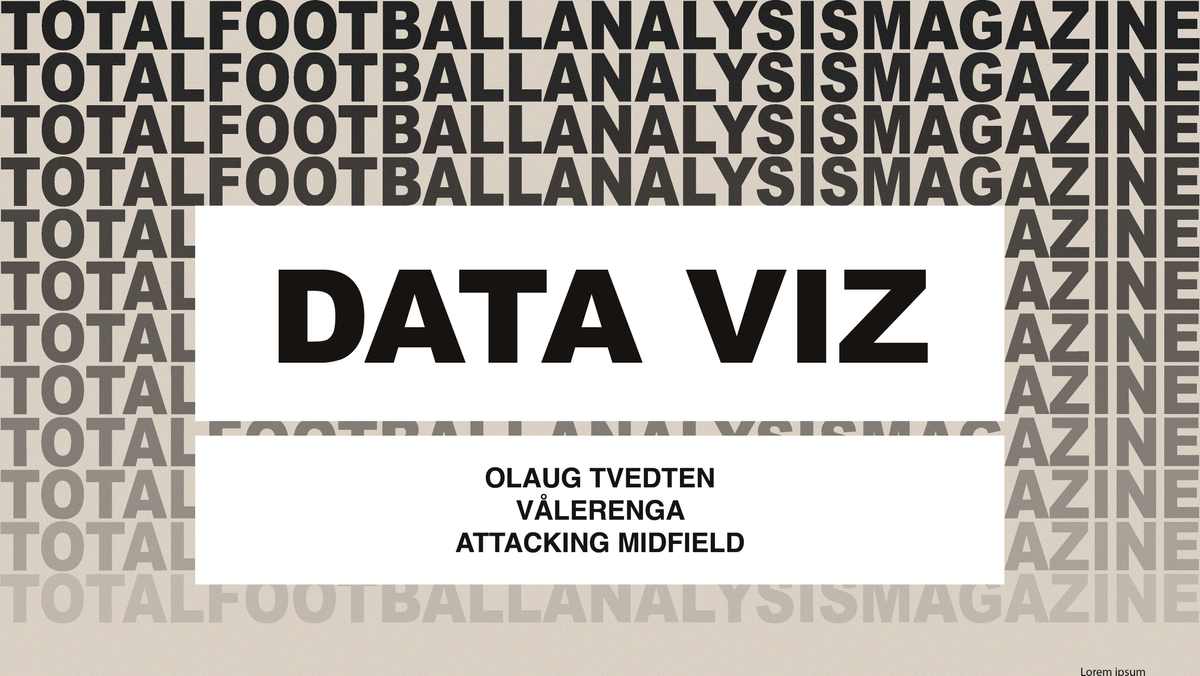
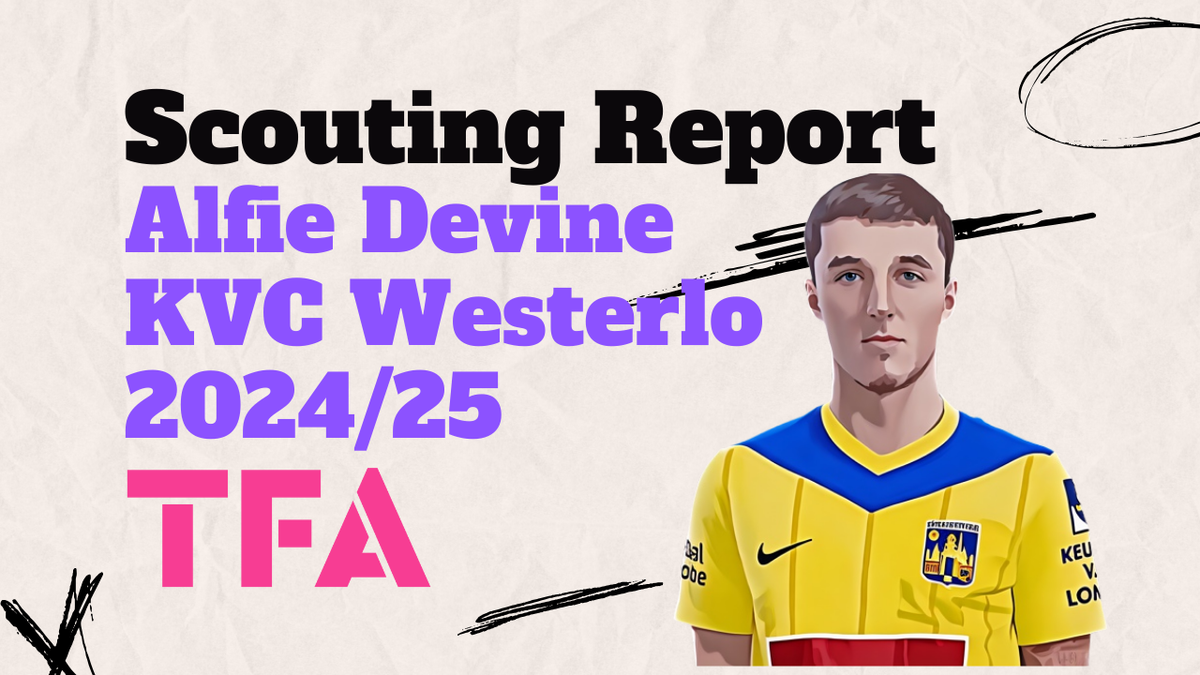
Comments